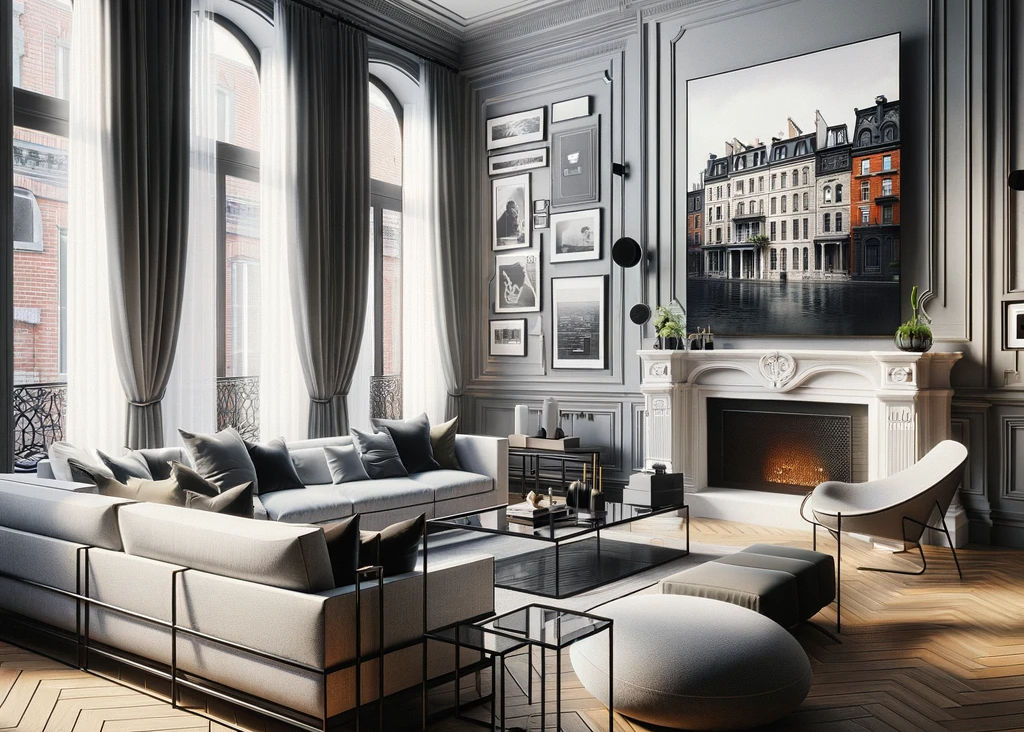
The Evolution of Elegance: Montreal’s Urban Interior Design Renaissance
January 2, 2024
A City Unlike Any Other in Continuous Transformation
In the heart of Canada’s Quebec province lies Montreal, a city that has become synonymous with an evolving aesthetic that marries historical charm with contemporary flair. This urban landscape, rich in history and buzzing with modernity, presents a unique canvas where interior design is not just about creating functional spaces but weaving a narrative that reflects the city’s vibrant past and dynamic present. The urban interior design renaissance in Montreal is a movement that has redefined elegance within the context of this bustling metropolis.
From the cobblestone streets of Old Montreal to the sleek skyscrapers downtown, the city’s architecture is a testament to its diverse historical influences. The French colonial era bestowed upon Montreal a legacy of ornate woodwork and stonemasonry, hallmarking a period when design equated to luxury and attention to detail. As the city evolved through the Victorian era, its urban spaces began to mirror the grandeur of the time, showcasing opulent designs that spoke to the city’s burgeoning industrial might.
Post-war Montreal Design Ethos
The shift towards modernism in the wake of World War II brought about a change in the city’s design ethos. Functionalism began to take precedence, favoring simplicity over the complex designs of the past. Montreal’s Expo 67 stood as a pivotal moment in this transition, catapulting the city onto the world stage with its futuristic structures and innovative design concepts that would influence the city’s aesthetic for years to come.
Into the Present-day: Montreal Contemporary Design
Today, Montreal’s contemporary design movements are characterized by an understated elegance. Minimalism reigns, with clean lines and neutral palettes creating serene, uncluttered spaces. Yet, there’s a growing emphasis on sustainability and eco-consciousness, with designers increasingly turning to green materials and practices to craft interiors that are not just beautiful but environmentally responsible.
The influence of Montreal’s cultural diversity is unmistakably present in its interior design. The city’s rich tapestry of cultures finds expression in the design elements that adorn its interiors, from residential to commercial spaces. Traditional motifs blend seamlessly with modern designs, creating interiors that are a celebration of Montreal’s multicultural heartbeat.
In residential design, there has been a surge in transforming traditional homes to reflect contemporary tastes while retaining historic charm. Heritage buildings are being thoughtfully updated, merging classic features like exposed brick walls and original hardwood floors with modern amenities and sleek furnishings.
Commercial spaces, too, are reimagining their interiors. Montreal’s restaurants, cafes, and boutiques are adopting avant-garde designs that enhance customer experience, turning these spaces into not just places of commerce but hubs of social and cultural interaction.
How Technology Plays a Role
Technology and innovation are also shaping the future of Montreal’s interior design. The rise of smart homes and intelligent buildings has introduced a new layer of convenience and efficiency. Automated systems for lighting, heating, and security are becoming standard, reflecting a growing desire for interiors that are not only aesthetically pleasing but also technologically advanced.
Influenced by the City’s Cultural Scene
The city celebrates its design evolution through various events and festivals. The Design Montreal Open House, for example, invites the public into the studios of local designers, providing a behind-the-scenes look at the creative processes that shape the city’s interiors. The SIDIM Design Show, meanwhile, offers a platform for designers from Montreal and beyond to showcase their latest creations, highlighting the city’s role as a burgeoning design hub on the international stage.
Yet, despite the exciting developments, Montreal’s design renaissance faces challenges. One of the most pressing issues is maintaining a balance between preserving the city’s architectural heritage and accommodating contemporary design needs. As new constructions rise, there’s a delicate balance to be struck in integrating modern design elements with the historic character that gives Montreal its unique charm.
Ensuring Accessibility for All
Affordability remains another concern. As design becomes a symbol of luxury and status, there is a growing need to ensure that stylish interiors are accessible to a wider demographic, not just the affluent. The question of how to democratize good design is one that continues to spark debate among the city’s design community.
In conclusion, Montreal’s urban interior design renaissance is about more than just aesthetics; it’s a reflection of the city’s soul. The blending of historical elements with modern trends, the infusion of cultural diversity into design, and the embrace of sustainability and technology, all speak to a city that is constantly reinventing itself while staying true to its roots. The evolution of elegance in Montreal’s interior design is an ongoing narrative, one that continues to captivate and inspire.
As the city looks to the future, it does so with an eye on the lessons of the past, ensuring that each space, whether a century-old home or a new commercial development, contributes to the collective story of Montreal’s design evolution. The elegance that defines Montreal’s interiors is a testament to the city’s spirit of innovation and its enduring love affair with beauty in all its forms.
For those who wish to delve deeper into the world of Montreal’s design renaissance or perhaps even become a part of it, the city awaits with open doors, ready to be discovered and appreciated in all its stylish glory.
© Ingrid Interiors Design Studio, Montreal 2023 - 2025
MONTREAL, QUEBEC
514.924.5553
info@ingridinteriordesign.com